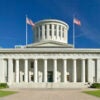A chart created by the Center on Budget and Policy Priorities (CBPP) has been circulating among liberal bloggers such as Ezra Klein, James Fallows, and Andrew Sullivan.
The chart, seen to the right, purports to show that the next decade’s deficits are entirely the result of the 2001 and 2003 tax cuts, wars, bailouts, recession, and stimulus.
The Daily Signal depends on the support of readers like you. Donate now
Their methodology fails statistics 101.
Imagine a basketball team that loses 100-98. It would make no sense to cherry pick one single basket by their opponent and blame it for 100 percent of the loss – letting all other baskets scored off the hook. Yet that is essentially what CBPP is doing.
Under a current-policy budget baseline, Washington will collect $33 trillion in taxes and spend $46 trillion over the next decade. One could cherry-pick any $13 trillion in spending or tax policies and blame them for the entire budget deficit. CBPP chose to pick the tax cuts, wars, stimulus/bailouts, and economic downturn to equal the sum of the deficit. One could have just as easily singled out Social Security and Medicaid (combined cost: $13 trillion), Medicare and net interest costs ($13 trillion), or discretionary spending ($15 trillion) for blame. There is no mathematical reason to single out the programs CBPP selected while ignoring the other costs.
So what is driving deficits? A better method would begin with historical averages and determine the moving variable altering the deficit. As the chart below shows, tax revenues (temporarily down due to the recession) are set to return to their 18 percent of GDP historical average once the economy recovers – even if all tax cuts are extended. Spending, on the other hand, is set to end the decade 6 percent of GDP above its historical average. Simply put the 6 percent of GDP deficit increase is the direct result of a 6 percent of GDP spending increase. There is no long-term revenue decline.
And what’s driving spending? The chart below shows the escalating costs of Social Security, Medicare, Medicaid, and net interest as responsible for nearly the entire inflation-adjusted spending increase projected over the next decade.
Liberals can spin the numbers any way they want: mandatory spending is the long-term moving variable driving deficits upward.

































